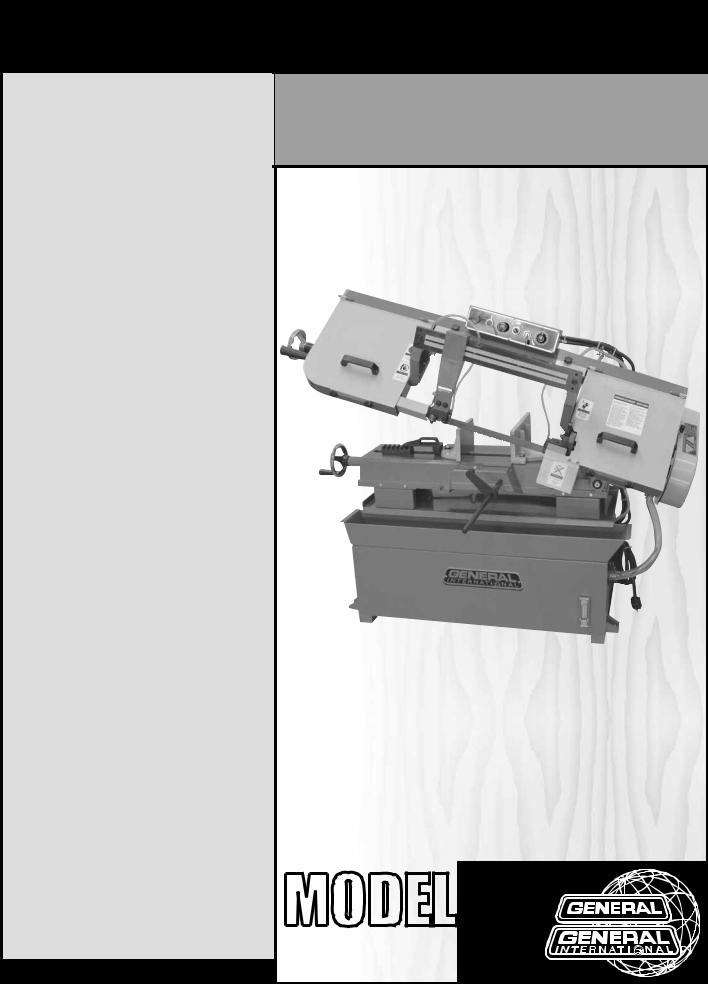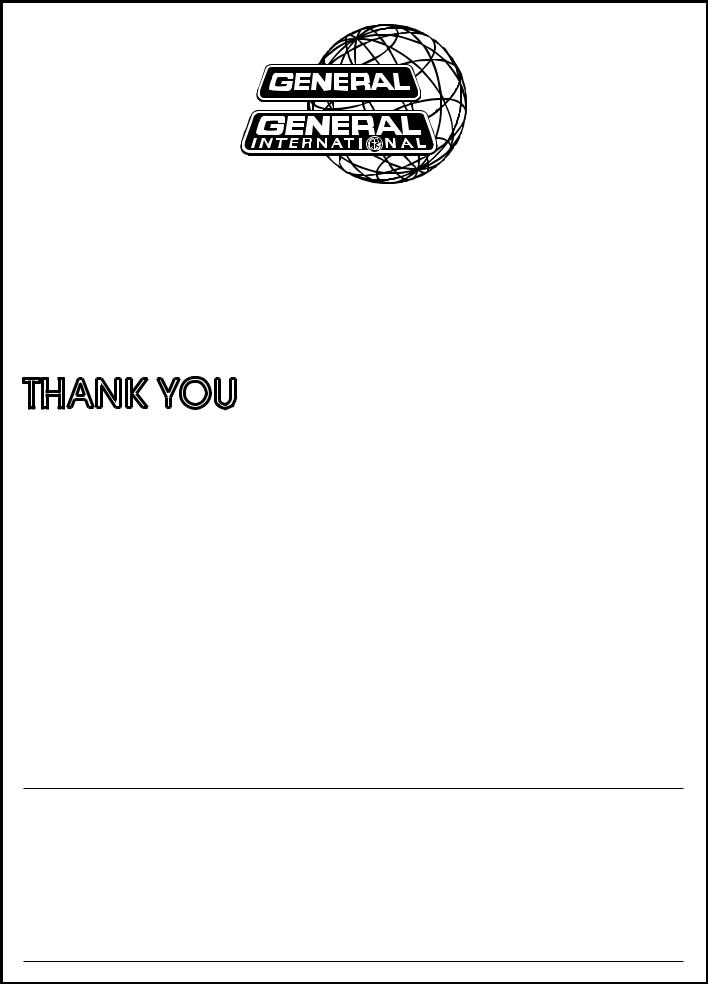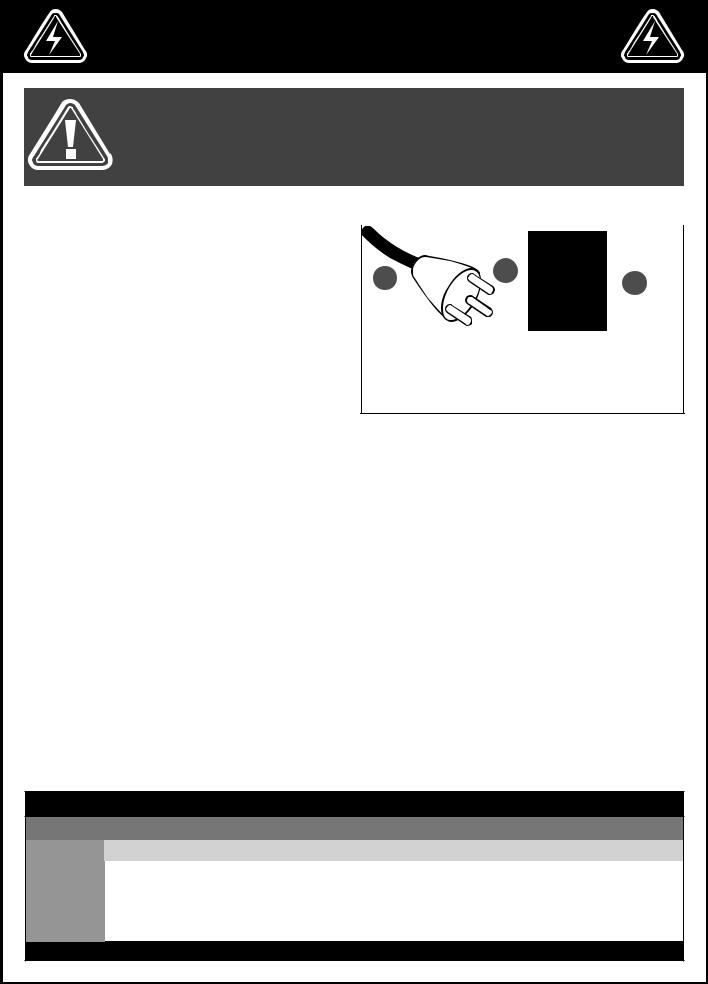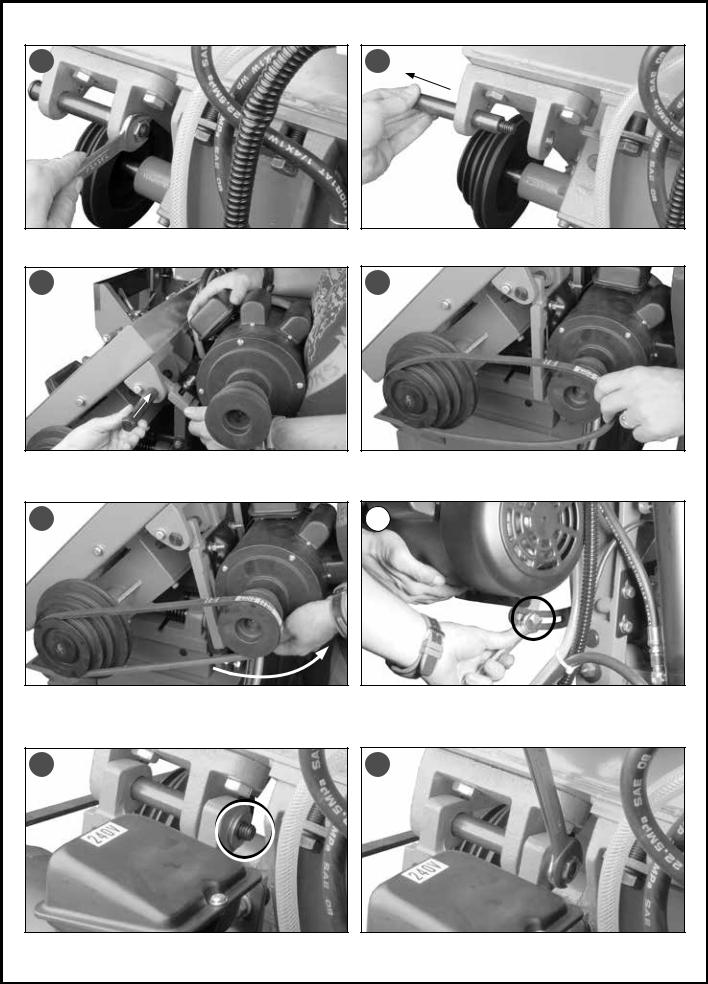General 90-790 User Manual

SETUP & OPERATION MANUAL
FEATURES
One-piece heavy-duty thick steel upper frame eliminates vibration.
Welded one-piece base made of high-quality steel with built-in coolant tank and recovery tray.
Precision machined and balanced high-quality cast-iron wheels.
Automatic shut-off at the end of cutting cycle. Chip brush and blade guard included.
Fully adjustable blade guide bearings. Built-in blade tension indicator.
Coolant system with built-in tank and pump.
Cast-iron vise with one fixed and one quickpositioning moveable jaw.
Adjustable hydraulic down feed control.
4 blade speeds to accommodate a wide range of cutting needs.
Magnetic safety switch with lock-out key.
SPECIFICATIONS
•Cutting capacity at 90º (Rectangular) 8 7/8” x 13 1/2” (225 x 345 mm)
& 1 3/8” x 15 3/4” (35 x 400 mm)
•Cutting capacity at 90º (Round) 8 7/8” (225 mm)
•Cutting capacity at 45º (Rectangular) 6 1/2” x 8 7/8” (165 x 225 mm)
•Cutting capacity at 45º (Round) 6 1/2” (165 mm)
•Blade size
1” X 0.032” X 119 1/2” (27 X 0.9 X 3035 mm)
•Blade speeds
82, 132, 170, 235 fpm (25, 40, 51, 71 mpm)
•Overall dimensions
64 3/4”x 44 1/4”x 42 1/2”(1645 x 1125 x 1080 mm)
•Motor
1/2 HP, 240 V, 1 PH, 8 A
•Shipping weight / Net weight 638 lbs (290 kg) / 543 lbs (247 kg)
Version #2_Revision #2 - April 2015
© Copyright General International
9” X 16” METAL CUTTING BANDSAW
MODEL
#90-790

GENERAL® INTERNATIONAL
8360 Champ-d’Eau, Montreal (Quebec) Canada H1P 1Y3 Telephone (514) 326-1161 • Fax (514) 326-5555 • www.general.ca
THANK YOU for choosing this General® International model 90-790 9” x 16” Metal Cutting Bandsaw. This bandsaw has been carefully tested and inspected before shipment and if properly used and maintained, will provide you with years of reliable service. For your safety, as well as to ensure optimum performance and trouble-free operation, and to get the most from your investment, please take the time to read this manual before assembling, installing and operating the unit.
The manual’s purpose is to familiarize you with the safe operation, basic function, and features of this bandsaw as well as the set-up, maintenance and identification of its parts and components. This manual is not intended as a substitute for formal metalworking instruction, nor to offer the user instruction in the craft of metalworking. If you are not sure about the safety of performing a certain operation or procedure, do not proceed until you can confirm, from knowledgeable and qualified sources, that it is safe to do so.
Once you’ve read through these instructions, keep this manual handy for future reference.
DISCLAIMER: The information and specifications in this manual pertain to the unit as it was supplied from the factory at the time of printing. Because we are committed to making constant improvements, General® International reserves the right to make changes to components, parts or features of this unit as deemed necessary, without prior notice and without obligation to install any such changes on previously delivered units. Reasonable care is taken at the factory to ensure that the specifications and information in this manual corresponds with that of the unit with which it
was supplied.However,special orders and“after factory” modifications may render some or all information in this manual inapplicable to your machine. Further, as several generations of this model of Metal Cutting Bandsaw and several versions of this manual may be in circulation, if you own an earlier or later version of this unit, this manual may not depict your unit exactly. If you have any doubts or questions contact your retailer or our support line with the model and serial number of your unit for clarification.

GENERAL® INTERNATIONAL WARRANTY
All component parts of General® International and Excalibur by General International® products are carefully inspected during all stages of production and each unit is thoroughly inspected upon completion of assembly.
Limited Lifetime Warranty
Because of our commitment to quality and customer satisfaction, General® International agrees to repair or replace any part or component which upon examination, proves to be defective in either workmanship or material to the original purchaser for the life of the tool. However, the Limited Lifetime Warranty does not cover any product used for professional or commercial production purposes nor for industrial or educational applications. Such cases are covered by our Standard 2-year Limited Warranty only. The Limited Lifetime Warranty is also subject to the “Conditions and Exceptions” as listed below.
Standard 2-Year Limited Warranty
All products not covered by our lifetime warranty including products used in commercial, industrial and educational applications are warranted for a period of 2 years (24 months) from the date of purchase. General® International agrees to repair or replace any part or component which upon examination, proves to be defective in either workmanship or material to the original purchaser during this 2-year warranty period, subject to the “conditions and exceptions” as listed below.
To file a Claim
To file a claim under our Standard 2-year Limited Warranty or under our Limited Lifetime Warranty, all defective parts, components or machinery must be returned freight or postage prepaid to General® International, or to a nearby distributor, repair center or other location designated by General® International. For further details call our service department at 1-888-949-1161 or your local distributor for assistance when filing your claim.
Along with the return of the product being claimed for warranty, a copy of the original proof of purchase and a“letter of claim”must be included (a warranty claim form can also be used and can be obtained, upon request, from General® International or an authorized distributor) clearly stating the model and serial number of the unit (if applicable) and including an explanation of the complaint or presumed defect in material or workmanship.
CONDITIONS AND EXCEPTIONS:
This coverage is extended to the original purchaser only. Prior warranty registration is not required but documented proof of purchase i.e. a copy of original sales invoice or receipt showing the date and location of the purchase as well as the purchase price paid, must be provided at the time of claim.
Warranty does not include failures, breakage or defects deemed after inspection by General® International to have been directly or indirectly caused by or resulting from; improper use, or lack of or improper maintenance, misuse or abuse, negligence, accidents, damage in handling or transport, or normal wear and tear of any generally considered consumable parts or components.
Repairs made without the written consent of General® International will void all warranty.

TABLE OF CONTENTS |
|
Rules for safe operation..................................................................................................... |
5 |
Electrical requirements....................................................................................................... |
6 |
Identification of main parts and components................................................................... |
7 |
Unpacking.......................................................................................................................... |
8 |
Basic functions................................................................................................................... |
8 |
Placement within the shop/Safety zone............................................................................ |
9 |
Assembly instructions.................................................................................................... |
9-12 |
Installing the control box.................................................................................................................................... |
9 |
Installing the motor...................................................................................................................................... |
10-11 |
Installing the pulley cover................................................................................................................................ |
11 |
Installing the workpiece stop........................................................................................................................... |
12 |
Basic adjustments and controls.................................................................................. |
12-21 |
Connecting to a power source....................................................................................................................... |
12 |
Main On/Off magnetic switch......................................................................................................................... |
12 |
Overload protection......................................................................................................................................... |
13 |
Changing the blade.................................................................................................................................... |
13-14 |
Adjusting blade tension.................................................................................................................................... |
15 |
Adjusting blade tracking.................................................................................................................................. |
15 |
Squaring the blade to the table work............................................................................................................ |
16 |
Squaring the vise to the blade........................................................................................................................ |
16 |
Adjusting the quick-set vise.............................................................................................................................. |
17 |
Adjusting the right and left blade guides...................................................................................................... |
17 |
Adjusting the carbon block guides................................................................................................................ |
18 |
Adjusting the right and left thrust bearings.................................................................................................... |
18 |
Adjusting the blade guard............................................................................................................................... |
19 |
Changing speeds.............................................................................................................................................. |
19 |
Speed selection chart....................................................................................................................................... |
19 |
Cutting feed rate/Saw arm tension................................................................................................................ |
20 |
Using the coolant pump................................................................................................................................... |
20 |
Filling the coolant tank..................................................................................................................................... |
20 |
Securing and leveling the machine............................................................................................................... |
21 |
Operating Instructions...................................................................................................... |
21 |
Checklist before starting................................................................................................................................... |
21 |
Operations step-by-step................................................................................................................................... |
21 |
Maintenance.................................................................................................................... |
22 |
Cleaning............................................................................................................................................................. |
22 |
Lubrication......................................................................................................................................................... |
22 |
Trouble shooting.......................................................................................................... |
23-24 |
Parts list & diagrams................................................................................................... |
25-31 |
Contact information......................................................................................................... |
32 |

RULES FOR SAFE OPERATION
To help ensure safe operation, please take a moment to learn the machine’s applications and limitations, as well as potential hazards. General® International disclaims any real or implied warranty and holds itself harmless for any injury that may result from the improper use of it’s equipment.
1.Do not operate the bandsaw when tired, distracted or under the effects of drugs, alcohol or any medIcation that impairs reflexes or alertness.
2.The work area should be well lit, clean and free of debris.
3.Keep children and visitors at a safe distance when the bandsaw is in operation; do not permit them to operate the bandsaw.
4.Childproof and tamper proof your shop and all machinery with locks, master electrical switches and switch keys, to prevent unauthorized or unsupervised use.
5.STAY ALERT! Give your work your undivided attention. Even a momentary distraction can lead to serious injury.
6.Fine particulate dust is a carcinogen that can be hazardous to health. Work in a well-ventilated area. Wear face, eye, ear, respiratory and body protection devices.
7.Do not wear loose clothing, gloves, bracelets, necklaces or other jewelry while the bandsaw is in operation.
8.Be sure that adjusting wrenches, tools, drinks and other clutter are removed from the machine and/or the table surface before operating.
9.Keep hands well away from the blade and all moving parts. Use a brush, not hands, to clear away chips and dust.
10.Adjust and position the blade guards as close as possible to the workpiece.
11.Adjust blade tension and tracking before starting to cut.
12.Blade teeth must point down toward the table.
13.Be sure that the blade has gained full operating speed before starting to cut.
14.Always use a clean, properly sharpened blade. Dirty or dull blades are unsafe and can lead to accidents.
15.Use suitable workpiece support if the workpiece does not have a flat surface.
16.Make sure the workpiece is securely held in place in the vise.
17.Do not work on long stock without adequate support on the out feed end of the table.
18.Do not push or force stock into the blade. The bandsaw will perform better and more safely when working at the rate for which it was designed.
19.Avoid working from awkward or off balance positions. Do not overreach and keep both feet on floor.
20.Keep guards in place and in working order. If a guard must be removed for maintenance or cleaning be sure it is properly re-attached before using the saw again.
21.Never leave the machine unattended while it is run-- ning or with the power on.
22.Use of parts and accessories NOT recommended by General® International may result in equipment malfunction or risk of injury.
23.Never stand on machinery. Serious injury could result if the tool is tipped over or if the cutting tool is unintentionally contacted.
24.Always disconnect the saw from the power source before servicing or changing accessories such as blades, or before performing any maintenance or cleaning, or if the machine will be left unattended.
25.Make sure that the switch is in the “OFF” position before plugging in the power cord.
26.Make sure the machine is properly grounded. If equipped with a 3-prong plug it should be used with a three-pole receptacle. Never remove the third prong.
27.Do not use this bandsaw for other than its intended use. If used for other purposes, General® International disclaims any real or implied warranty andholds itself harmless for any injury, which may resultfrom that use.
5

ELECTRICAL REQUIREMENTS
BEFORE CONNECTING THE MACHINE TO THE POWER SOURCE, VERIFY THAT THE VOLTAGE OF YOUR POWER SUPPLY CORRESPONDS WITH THE VOLTAGE SPECIFIED ON THE MOTOR I.D. NAMEPLATE. A POWER SOURCE WITH GREATER VOLTAGE THAN NEEDED CAN RESULT IN SERIOUS INJURY TO THE USER AS WELL AS DAMAGE TO THE MACHINE. IF IN DOUBT, CONTACT A QUALIFIED ELECTRICIAN BEFORE CONNECTING TO THE POWER SOURCE.
THIS TOOL IS FOR INDOOR USE ONLY. DO NOT EXPOSE TO RAIN OR USE IN WET OR DAMP LOCATIONS.
GROUNDING INSTRUCTIONS |
|
|
|
In the event of an electrical malfunction or short cir- |
|
|
|
|
|
||
cuit, grounding reduces the risk of electric shock to |
|
|
|
the operator. |
A |
B |
|
|
|||
The motor of this machine is wired for 240 V single |
C |
||
|
|||
phase operation and is equipped with a 3-conduc- |
|
|
|
tor cord A and a 3-prong grounded plug B to fit a |
|
|
|
matching grounding type receptacle C. |
|
|
DO NOT MODIFY THE PLUG PROVIDED! If it will not fit your receptacle, have the proper receptacle installed by a qualified electrician.
CHECK with a qualified electrician or service person if you do not completely understand these grounding instructions, or if you are not sure the tool is properly grounded.
CIRCUIT CAPACITY
Make sure that the wires in your circuit are capable of handling the amperage draw from your machine, as well as any other machines that could be operating on the same circuit.
If you are unsure, consult a qualified electrician. If the circuit breaker trips or the fuse blows regularly, your machine may be operating on a circuit that is close to its amperage draw capacity.
However, if an unusual amperage draw does not exist and a power failure still occurs, contact a qualified technician or our service department.
EXTENSION CORDS
The use of an extension cord is not generally recommended for 240 V equipment. If you find it necessary, use only 3-wire extension cords that have 3-prong grounding plug and a matching 3-pole receptacle that accepts the tool’s plug. Repair or replace a damaged extension cord or plug immediately.
If you find it necessary to use an extension cord with your machine make sure the cord rating is suitable for the amperage listed on the motor I.D. plate. An undersized cord will cause a drop in line voltage resulting in loss of power and overheating.
The accompanying chart shows the correct size extension cord to be used based on cord length and motor I.D. plate amp rating. If in doubt, use the next heavier gauge. The smaller the number, the heavier the gauge.
TABLE - MINIMUM GAUGE FOR CORD
EXTENSION CORD LENGTH
AMPERES |
50 feet |
100 feet |
200 feet |
300 feet |
|
|
|
|
|
< 5 |
18 |
16 |
16 |
14 |
|
|
|
|
|
6 to 10 |
18 |
16 |
14 |
12 |
|
|
|
|
|
10 to 12 |
16 |
16 |
14 |
12 |
12 to 16 |
14 |
12 |
*NR |
*NR |
*NR = Not Recommended
6

IDENTIFICATION OF MAIN PARTS AND COMPONENTS
R  I P E F G H
I P E F G H
I
A
K
B  J
J
C
D
S
L
O Q
N
M
 T
T
A. |
BLADE TENSIONING HANDLE |
K. |
PULLEY COVER |
B. |
BLADE ARM |
L. |
COOLANT RECOVERY TRAY |
C. |
VISE |
M. |
COOLANT LEVEL GAUGE |
D. |
VISE ADJUSTMENT HANDWHEEL |
N. |
STAND |
E. |
ON/OFF SWITCH |
O. |
WORKPIECE STOP |
F. |
COOLANT PUMP SWITCH |
P. |
BLADE GUARD & LEFT BLADE GUIDE |
G. |
MAIN OFF SWITCH WITH SAFETY KEY |
Q. |
RIGHT GUIDE BEARINGS |
H. |
HYDRAULIC DOWNFEED CONTROL VALVE |
R. |
BLADE TENSION INDICATOR |
I. |
WHEEL COVERS (2) |
S. |
VISE QUICK ADJUSTMENT HANDLE |
J. |
BLADE |
T. |
LEVELING FEET (4) |
7

UNPACKING
Carefully unpack and remove the unit and its components from its shipping container and check for missing or damaged items as per the list of contents below.
NOTE: PLEASE REPORT ANY DAMAGED OR MISSING ITEMS TO YOUR GENERAL® INTERNATIONAL DISTRIBUTOR IMMEDIATELY.
LIST |
OF CONTENTS |
|
QTY |
|
|
|
|
|
A. |
PULLEY COVER |
......................................................................... |
|
1 |
|
|
B |
C |
B. |
LOCK KNOB |
|
|
1 |
|
|
||
|
|
|
|
|
|
|||
C. |
STOP SHAFT............................................................................... |
|
|
1 |
|
|
|
|
D. |
BELT........................................................................................... |
|
|
1 |
|
|
|
|
E. |
WORKPIECE STOP..................................................................... |
|
1 |
|
|
|
|
|
F. |
HEX HEAD BOLT........................................................................ |
|
4 |
|
|
|
|
|
G. |
NUT............................................................................................ |
|
|
4 |
|
|
|
|
H. |
FLAT HEAD SCREWDRIVER....................................................... |
|
1 |
|
|
|
|
|
I. |
PHILLIPS SCREWDRIVER ........................................................... |
|
1 |
|
|
A |
|
|
J. |
17 -19 MM WRENCH |
|
1 |
|
|
|
||
|
|
|
D |
|
||||
K. |
11 -13 MM WRENCH................................................................ |
|
1 |
|
|
|
|
|
L. |
3, 4, 5 6 MM ALLEN ..........................................................KEYS |
|
1 |
|
|
|
|
|
M. MOTOR..................................................................................... |
|
|
1 |
|
|
|
|
|
|
ADDITIONAL REQUIREMENTS FOR SET UP |
|
|
|
E |
F |
|
|
|
|
|
|
|
|
|||
|
A. EXTRA PERSON FOR HELP WITH LIFTING |
|
|
|
|
G |
|
|
|
|
|
|
|
|
|
||
|
B. SQUARE |
|
|
|
|
|
|
|
|
C. 10 & 14 MM WRENCHES |
|
|
M |
|
H |
|
|
|
D. GLOVES |
|
|
|
|
|
|
|
|
|
|
|
|
|
I |
|
|
|
|
|
|
|
|
|
|
|
|
A |
B |
|
|
|
|
J |
|
|
D |
|
|
|
K |
|
||
|
|
C |
|
|
|
|
||
|
|
|
|
|
|
|
|
|
|
|
|
|
|
|
|
L |
|
BASIC FUNCTIONS
This 9” x 16” horizontal metal cutting band saw is designed for horizontal cutting in metalworking and machine shops for cutting various types of bar stock, channel stock, piping, and thin-walled tubing.
With four blade speeds to accommodate a wide range of cutting needs, the unit features an automatic hydraulically controlled down feed with auto shut off at the end of the cutting cycle.
The coolant system with built-in pump is designed to supply a continuous flow of liquid coolant to the cutting area to prevent overheating of both the blade and the workpiece, providing cleaner cuts and prolonging blade life.
8

PLACEMENT WITHIN THE SHOP / SAFETY ZONE
THIS METAL CUTTING BANDSAW 90-790 IS HEAVY. DO NOT OVER-EXERT. A HOIST OR FORKLIFT WITH STRAPS SHOULD BE USED TO LIFT THIS MACHINE. TO LIMIT THE RISK OF SERIOUS INJURY OR DAMAGE TO THE MACHINE, ANY EQUIPMENT USED TO LIFT THIS MACHINE SHOULD HAVE A RATED CAPACITY IN EXCESS OF 543 LBS (247 KG).
PLACEMENT WITHIN THE SHOP |
|
This machine should be installed and operated only on |
|
a solid, flat and stable floor that is able to support the |
64" |
weight of the machine (543 lbs - 247 kg) and the opera- |
|
tor. Using the dimensions shown as a guideline, plan for |
|
placement within your shop that will allow the operator |
|
to work unencumbered and unobstructed by foot traf- |
|
fic (either passing shop visitors or other shop workers) or |
|
other tools or machinery. |
|
ESTABLISHING A SAFETY ZONE |
|
For shops with frequent visitors or multiple operators, |
|
it is advisable to establish a safety zone around shop |
|
machinery. A clearly defined “no-go” zone on the floor |
|
around each machine can help avoid accidents that |
19" |
could cause injury to either the operator or the shop |
|
visitor. |
|
It is advisable to take a few moments to either paint |
|
(using non-slip paint) or using tape, define on the floor |
|
the limits or perimeter of each machines safety zone. |
|
Take steps to ensure that all operators and shop visi- |
40" |
tors are aware that these areas are off limits whenever |
|
a machine is running for everyone but the individual |
|
operating the unit. |
|
ASSEMBLY INSTRUCTIONS
BEFORE ASSEMBLING, MAKE SURE THAT THE SWITCH IS IN THE “OFF” POSITION AND THAT THE POWER CORD IS UNPLUGGED. DO NOT PLUG IN OR TURN ON THE MACHINE UNTIL YOU HAVE COMPLETED THE ASSEMBLY AND INSTALLATION STEPS DESCRIBED IN THIS SECTION OF THE MANUAL.
INSTALLING THE CONTROL BOX
A |
C |
|
|
B |
D |
1.Remove the bolts and washers located on the top 2. Align the box mounting holes with the correspond-
of the saw arm A using a 10 mm wrench and then |
ing holes in the machine C and secure the box us- |
position the control box on the arm B. |
ing the bolts and washers you just removed D. |
9

INSTALLING THE MOTOR
A
1. Remove the nut and the flat washer from the motor mounting shaft with a 19 mm wrench A.
C
3. With assistance, position the motor base onto its mounting bracket and then re-insert the mounting shaft all the way in C.
E
5. Pull back the motor as much as possible to tension the belt and hold it in place E.
G
7. Re-install the flat washer on the motor mounting shaft G.
10
B
2. Remove the shaft B.
D
4. Install the belt on the pulleys D.
F
6. Secure the motor base to its mounting bracket using the bolt and the washer already installed F.
Note: Push on the belt with your finger. The belt should not move more than 1/2”
H
8. Gently retighten the nut H to avoid breaking the retention ring on the shaft.
